Ditapis dengan

Decommissioning of Medical, Industrial and Research Facilities, Safety Guide
This Safety Guide addresses the subject of how to meet the requirements for the decommissioning of medical, industrial and research facilities where radioactive materials and sources are produced, received, used and stored. It provides guidance to national authorities and operating organizations, particularly to those in developing countries (as such facilities are predominant in these countrie…
- Edisi
- -
- ISBN/ISSN
- 9201020886 / 1020525X
- Deskripsi Fisik
- 37 p. : Illus. ; 24 cm
- Judul Seri
- Safety Standards Series No. WS-G-2.2
- No. Panggil
- 362.1 IAE d
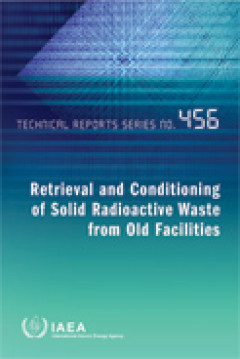
Retrieval and Conditioning of Solid Radioactive Waste from Old Facilities
This report provides information and discussion on planning, methodologies and technologies for retrieval and reconditioning of radioactive wastes recovered from old, inadequate disposal or storage facilities. The objective is to improve waste safety and security in accordance with modern requirements. Selected international experiences in waste retrieval and recovery projects are included. The…
- Edisi
- -
- ISBN/ISSN
- 9201124066 / 00741914
- Deskripsi Fisik
- 161 p. : Illus. ; 24 cm
- Judul Seri
- Technical Reports Series No. 456
- No. Panggil
- -
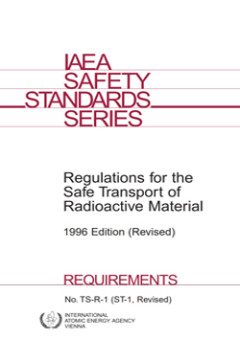
Regulations for the Safe Transport of Radioactive Material, 1996 Edition (Rev…
This publication, Safety Standards Series No. TS-R-1, is an updated version of Safety Standards Series No. ST-1, which was a revised version of Safety Series No. 6 superseding all previous edition. It also includes the revision of Safety Series No. 80, Schedules of Requirements for the Transport of Specified Types of Radioactive Material Consignments (As Amended in 1990). These Regulations, fir…
- Edisi
- -
- ISBN/ISSN
- 9201005008 / 1020525X
- Deskripsi Fisik
- 220 p. : Illus. ; 24 cm
- Judul Seri
- Safety Standards Series No. TS-R-1 (ST-1, Revised)
- No. Panggil
- -
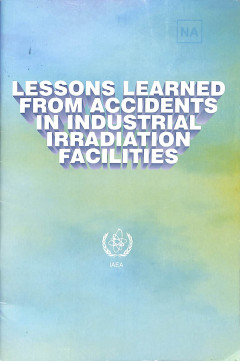
Lessons Learned from Accidents in Industrial Irradiation Facilities
This book consist : Introduction; Brief description of accidents; Major causes of accidents and lessons learned; and Prevention and remedial actions. (Jml)
- Edisi
- -
- ISBN/ISSN
- 920102696X
- Deskripsi Fisik
- 52 p. : Illus. ; 24 cm
- Judul Seri
- -
- No. Panggil
- 621.48 IAE l
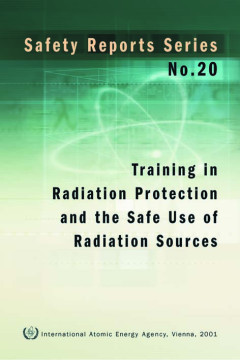
Training in Radiation Protection and the Safe Use of Radiation Sources
This report provides assistance in how to organize adequate and appropriate training for personnel working with ionizing radiation. It is primarily intended to be used by trainers and training providers, and covers among other topics the various methods of training provision and gives advice on the development and organizational aspects associated with the management of training activities. It …
- Edisi
- -
- ISBN/ISSN
- 9201006012/10206450
- Deskripsi Fisik
- 69 p. : Illus. ; 24 cm
- Judul Seri
- Safety Reports Series No. 20
- No. Panggil
- -

Organization and Implementation of a National Regulatory Infrastructure Gover…
This book consist : Introduction; Legal framework for a radiation protection and safety infrastructure; Basic elements of a regulatory programme; Role of the regulatory authority in emergency; Role of the regulatory authority in relation to intervention in chronic exposure situations; and Assessment of the effectiveness of the regulatory programme. (Jml)
- Edisi
- -
- ISBN/ISSN
- 10114289
- Deskripsi Fisik
- 150 p. : Illus. ; 29 cm
- Judul Seri
- IAEA-TECDOC-1067
- No. Panggil
- 539.722 IAE o
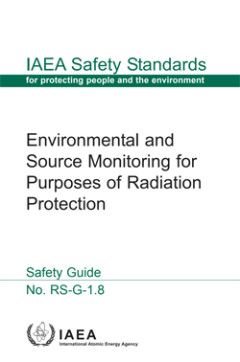
Environmental and Source Monitoring for Purposes of Radiation Protection, Saf…
The purpose of this Safety Guide is to provide international guidance, coherent with contemporary radiation protection principles and IAEA safety requirements, on the strategy of monitoring in relation to: (a) control of radionuclide discharges under practice conditions, and (b) intervention, such as in cases of nuclear or radiological emergencies or past contamination of areas with long lived …
- Edisi
- -
- ISBN/ISSN
- 9201134045 / 1020525X
- Deskripsi Fisik
- 119 p. : Illus. ; 24 cm
- Judul Seri
- Safety Standards No. RS-G-1.8
- No. Panggil
- -

Security of Radioactive Sources: Proceedings of an International Conference H…
Accidents involving radioactive sources and reports of illicit trafficking in radioactive materials have raised awareness of the safety and security risks created by sources that are outside effective control, and the attacks of 11 September 2001 have triggered international concern about the potential malevolent use of radioactive sources by terrorist groups. The International Conference on Se…
- Edisi
- -
- ISBN/ISSN
- 9201074034 / 00741884
- Deskripsi Fisik
- 617 p. : Illus. ; 24 cm
- Judul Seri
- Proceedings Series
- No. Panggil
- 363.17996 IAE S
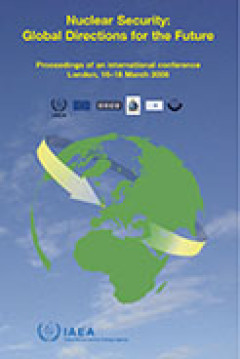
Proceedings Series - Nuclear Security: Global Directions for the Future
The principal aim of the International Conference on Nuclear Security: Global Directions for the Future was to share information on how to most successfully combat sub-State and criminal threats now and in the future, and to foster a better understanding and awareness of the global changes since 11 September 2001. The conference considered the threat of malicious acts involving nuclear and othe…
- Edisi
- -
- ISBN/ISSN
- 92-0-105905-1 / 0074-1884
- Deskripsi Fisik
- 326 p.
- Judul Seri
- -
- No. Panggil
- R539.2 NUC
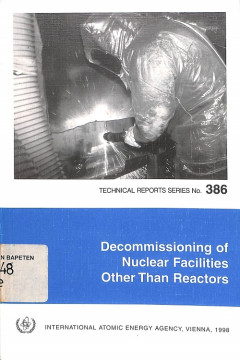
Decommissioning of Nuclear Facilities Other Than Reactors
This book consist : Introduction; Overview on non-reactor nuclear facilities; Basic safety and radiological protection; Decommissioning strategy and planning; Decommissioning techniques and equipment; Design and operational features to simplify decommissioning; Decommissioning experience; and Conclusions. (jml)
- Edisi
- -
- ISBN/ISSN
- 9201009984 / 00741914
- Deskripsi Fisik
- 205 p. : Illus. ; 24 cm
- Judul Seri
- Technical Reports Series nO. 386
- No. Panggil
- 621.48 IAE d
 Karya Umum
Karya Umum  Filsafat
Filsafat  Agama
Agama  Ilmu-ilmu Sosial
Ilmu-ilmu Sosial  Bahasa
Bahasa  Ilmu-ilmu Murni
Ilmu-ilmu Murni  Ilmu-ilmu Terapan
Ilmu-ilmu Terapan  Kesenian, Hiburan, dan Olahraga
Kesenian, Hiburan, dan Olahraga  Kesusastraan
Kesusastraan  Geografi dan Sejarah
Geografi dan Sejarah